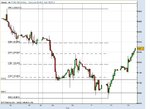B
Beartop
Making a case for Fibonacci.
Dow jones on the 25/02/07 looked good (Similar to Nikkie of last post)with two waves beginning of third,Doji followed by Hammer
and Emas 4&15 about to cross.Also Momentum Indicators had switched on each previous wave. Decided to wait until EMAs crossed and Momentum indicators switched.
Updated Data today on Dow Jones Industrial(Yahoo) and large drop.
So to Fibonacci,Today 27/02/07 (is now 12.40am just trading in USA 28/02/07) Fibonacci is still around 12529, My momentum indicators are still yet to switch(and red). My adjusted Fibonacci at 50% is near 12380.
If I was forced to trade I would take 12380 as my target over 3 days.Close once reach,conservative.
Without the momentum switch(Being ROC fibonacci) I would prefer to wait.
Case for Fibonacci
Dow jones on the 25/02/07 looked good (Similar to Nikkie of last post)with two waves beginning of third,Doji followed by Hammer
and Emas 4&15 about to cross.Also Momentum Indicators had switched on each previous wave. Decided to wait until EMAs crossed and Momentum indicators switched.
Updated Data today on Dow Jones Industrial(Yahoo) and large drop.
So to Fibonacci,Today 27/02/07 (is now 12.40am just trading in USA 28/02/07) Fibonacci is still around 12529, My momentum indicators are still yet to switch(and red). My adjusted Fibonacci at 50% is near 12380.
If I was forced to trade I would take 12380 as my target over 3 days.Close once reach,conservative.
Without the momentum switch(Being ROC fibonacci) I would prefer to wait.
Case for Fibonacci
Last edited by a moderator:


